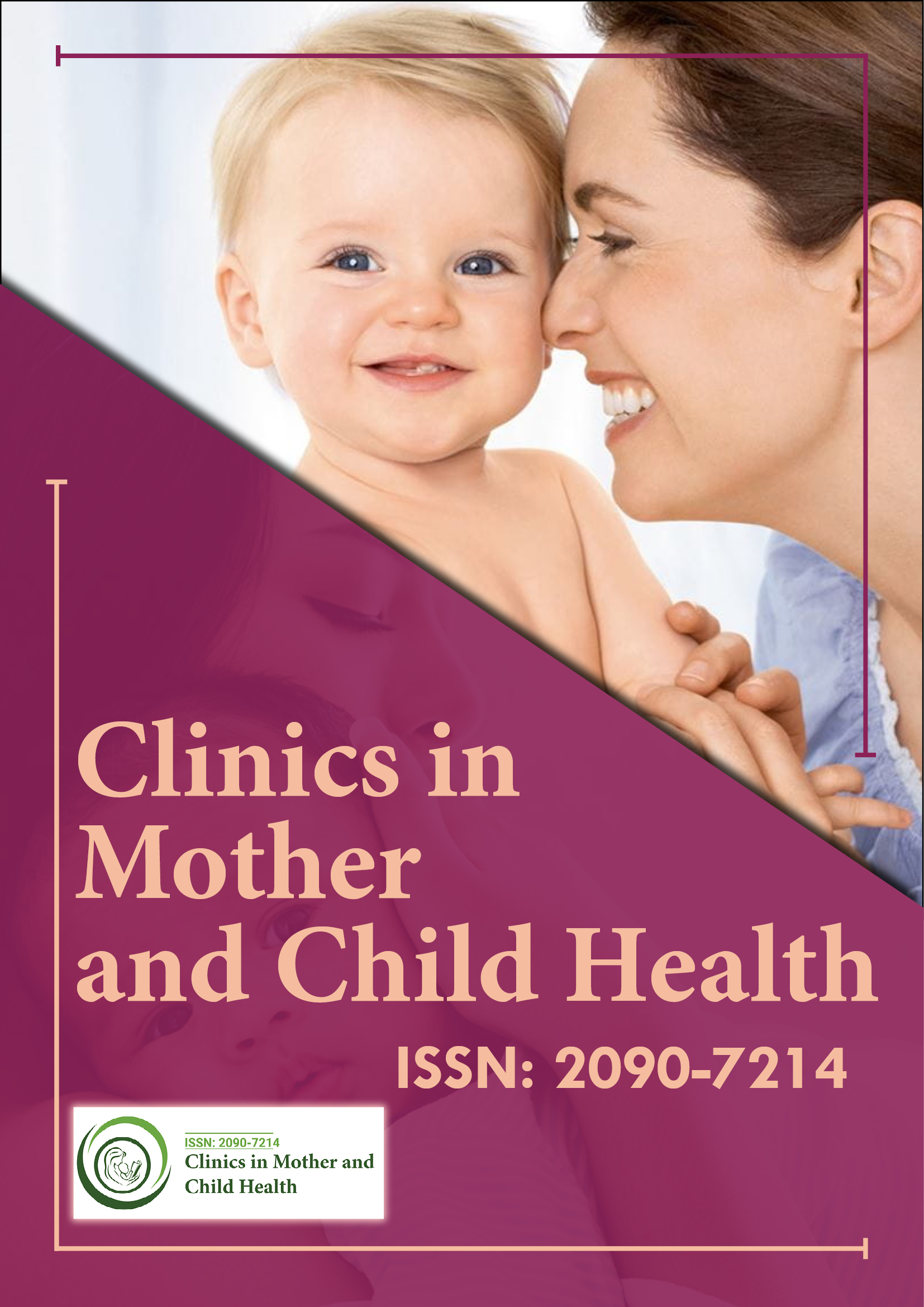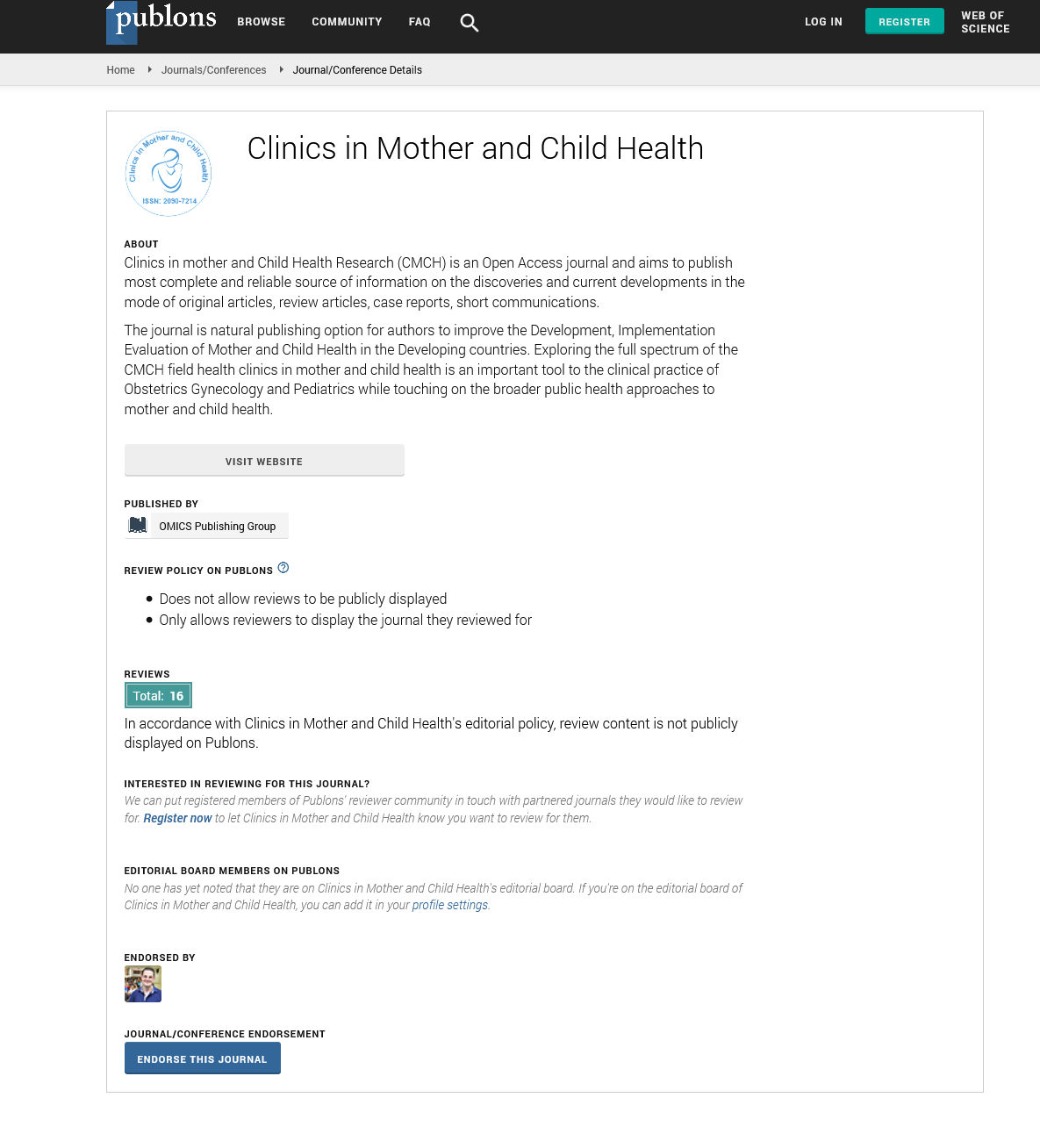Indexed In
- Genamics JournalSeek
- RefSeek
- Hamdard University
- EBSCO A-Z
- Publons
- Geneva Foundation for Medical Education and Research
- Euro Pub
- Google Scholar
Useful Links
Share This Page
Journal Flyer

Open Access Journals
- Agri and Aquaculture
- Biochemistry
- Bioinformatics & Systems Biology
- Business & Management
- Chemistry
- Clinical Sciences
- Engineering
- Food & Nutrition
- General Science
- Genetics & Molecular Biology
- Immunology & Microbiology
- Medical Sciences
- Neuroscience & Psychology
- Nursing & Health Care
- Pharmaceutical Sciences
Short Communication - (2025) Volume 22, Issue 5
Department of Neonatology University of Zurich Zurich Switzerland
Anna KellerReceived: 01-May-2025, Manuscript No. CMCH-25-29584; Editor assigned: 03-May-2025, Pre QC No. CMCH-25-29584; Reviewed: 17-May-2025, QC No. CMCH-25-29584; Revised: 26-May-2025, Manuscript No. CMCH-25-29584; Published: 31-May-2025, DOI: 10.35248/2090-7214.25.22.523
Description
Preterm birth, defined as delivery before 37 completed weeks of gestation, remains one of the leading causes of neonatal morbidity and mortality worldwide. Infants born prematurely often face immediate medical challenges, including respiratory distress, feeding difficulties and increased vulnerability to infections. Advances in neonatal intensive care over the past few decades have greatly improved survival rates for preterm infants; however, the long-term challenges associated with preterm birth continue to demand significant attention from healthcare providers, families and policymakers alike. Addressing both the immediate and long-term needs of these infants requires a multidisciplinary approach that spans from intensive neonatal care to ongoing follow-up throughout childhood [1].
One of the most immediate concerns in preterm infants is respiratory immaturity. Underdeveloped lungs often necessitate mechanical ventilation and supplemental oxygen therapy, which carry risks of complications such as bronchopulmonary dysplasia, a form of chronic lung disease. Research into surfactant replacement therapy has revolutionized the management of respiratory distress syndrome, significantly reducing mortality rates in preterm infants. Despite these advances, ongoing management of respiratory health remains critical even after discharge, as preterm infants are at higher risk of recurrent respiratory infections, asthma and impaired pulmonary function in later childhood. Parents often experience significant anxiety regarding the frequent need for medical follow-up and the potential long-term impact on their child’s respiratory health [2].
Neurological outcomes represent another major area of concern. The developing brain is highly susceptible to injury during the preterm period, resulting in increased risks of cerebral palsy, learning disabilities and behavioral challenges. Early intervention programs, including physical therapy, occupational therapy and speech therapy, have proven essential in optimizing developmental outcomes and supporting neuroplasticity in the immature brain. These services require well-coordinated healthcare systems that ensure continuity of care beyond the neonatal intensive care unit, extending into early childhood education and community-based support programs. Regular developmental assessments and timely interventions can significantly enhance cognitive, motor and social outcomes in preterm children [3].
Nutritional management of preterm infants is a delicate and critical aspect of care. Adequate intake of proteins, vitamins and minerals is vital to promote catch-up growth, organ maturation and optimal brain development. Breast milk remains the preferred source of nutrition due to its immunological benefits and protective effects against necrotizing enterocolitis, a severe gastrointestinal condition. However, preterm infants frequently require fortified breast milk or specialized formulas to meet their higher nutritional demands. Continuous monitoring of growth parameters, including weight, length and head circumference, ensures that nutritional interventions are appropriately adjusted according to the individual needs of each infant, supporting both short-term health and long-term developmental potential [4].
The psychological and social aspects of preterm birth profoundly affect families. Parents often experience heightened stress, depression and feelings of helplessness during prolonged hospitalizations and complex medical care. Family-centered care models, which actively involve parents in decision-making and caregiving activities, have been shown to reduce psychological distress, improve parental confidence and enhance bonding with the infant. Peer support groups, where parents can share experiences and coping strategies, also provide critical emotional support and reduce feelings of isolation. Health disparities further exacerbate the burden of preterm birth, as survival rates and long-term outcomes are strongly influenced by socioeconomic status. Families with limited resources may face barriers in accessing follow-up care, developmental therapies and specialized education. Public health strategies must therefore address these inequalities by ensuring universal access to neonatal services and long-term support programs regardless of socioeconomic background [5].
Preventive strategies for preterm birth are equally essential. Risk factors include maternal infections, hypertensive disorders, multiple pregnancies and lifestyle factors such as smoking, poor nutrition and inadequate prenatal care. Comprehensive antenatal care plays a crucial role in identifying and managing these risks, including early screening, timely interventions and appropriate maternal education [6]. Public health campaigns that promote healthy pregnancies, combined with medical interventions such as progesterone supplementation in high-risk women and cervical cerclage in selected cases, have been shown to reduce preterm birth rates. Addressing modifiable risk factors, including maternal stress, infection control and lifestyle behaviors, remains a cornerstone of preventive efforts [7].
Preterm birth is not only a medical issue but also a long-term societal challenge, affecting healthcare systems, educational institutions and family dynamics. Continued investment in neonatal care research, parental support systems, preventive strategies and policy interventions is essential. By addressing both the immediate medical needs and the long-term developmental, social and educational challenges associated with preterm birth, healthcare systems can improve survival, quality of life and developmental outcomes for millions of children worldwide, ultimately reducing the broader societal and economic burden associated with premature birth [8-10].
References
- Leo S, Curtis N, Zimmermann P. The neonatal intestinal resistome and factors that influence it: A systematic review. Clin Microbiol Infect. 2022;28(11):1539-1546.
[Crossref] [Google Scholar] [PubMed]
- Hourigan SK, Subramanian P, Hasan NA, Ta A, Klein E, Chettout N, et al. Comparison of infant gut and skin microbiota, resistome and virulome between neonatal intensive care unit (NICU) environments. Front Microbiol. 2018;9:1361.
[Crossref] [Google Scholar] [PubMed]
- Cason C, D Accolti M, Campisciano G, Soffritti I, Ponis G, Mazzacane S, et al. Microbial contamination in hospital environment has the potential to colonize preterm newborns’ nasal cavities. Pathogens. 2021;10(5):615.
[Crossref] [Google Scholar] [PubMed]
- Sachs RE, Edelstein CA. Ensuring the safe and effective FDA regulation of fecal microbiota transplantation. J Law Biosci. 2015;2(2):396-415.
[Crossref] [Google Scholar] [PubMed]
- Goldsmith J, Tomkovich S, AuniÅ?š JG, McGovern BH, Mahoney JC, Hasson BR, et al. End-to-end donor screening and manufacturing controls: Complementary quality-based strategies to minimize patient risk for donor-derived microbiome therapeutics. Gut Microbes. 2024;16(1):2402550.
[Crossref] [Google Scholar] [PubMed]
- Deepti I, Chettri B, Mehra A, Pinheiro AM, Ravi R. Faecal microbiota transplantation for recurrent Clostridioides difficile infection & its global regulatory landscape. Indian J Med Res. 2025;161(2):113-119.
[Crossref] [Google Scholar] [PubMed]
- Garrigues Q, Apper E, Mercier F, Rodiles A, Rovere N, Chastant S, et al. Composition of the fecal, vaginal and colostrum microbiotas of dams at parturition and their relationship with neonatal outcomes in dogs. Anim Microbiome. 2025;7(1):23.
[Crossref] [Google Scholar] [PubMed]
- Westaway JAF, Huerlimann R, Miller CM, Kandasamy Y, Norton R, Rudd D. Methods for exploring the faecal microbiome of premature infants: A review. Matern Health Neonatol Perinatol. 2021;7:11.
[Crossref] [Google Scholar] [PubMed]
- Devarajalu P, Kumar J, Dutta S, Attri SV, Kabeerdoss J. Gut microbiota alteration in healthy preterm infants: An observational study from tertiary care center in India. Microbe. 2025;13(3):577.
[Crossref] [Google Scholar] [PubMed]
- Daloiso V, Minacori R, Refolo P, Sacchini D, Craxì L, Gasbarrini A, et al. Ethical aspects of fecal microbiota transplantation (FMT). Eur Rev Med Pharmacol Sci. 2015;19(17):3173-3180.
[Google Scholar] [PubMed]
Citation: Keller A (2025). Addressing Preterm Birth and Its Long-Term Challenges. 22:523.
Copyright: © 2025 Keller A. This is an open-access article distributed under the terms of the Creative Commons Attribution License, which permits unrestricted use, distribution and reproduction in any medium, provided the original author and source are credited.

